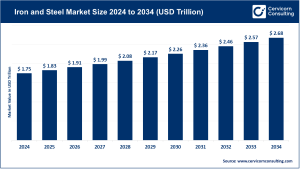Market Overview
The India specialty chemicals market is becoming an increasingly important part of the country’s manufacturing and industrial ecosystem. The market was valued at USD 62.78 billion in 2024 and is projected to reach USD 96.73 billion by 2034, expanding at a CAGR of 4.41% from 2025 to 2034.
Specialty chemicals are performance-based formulations designed for specific applications rather than bulk commodity use. They cater to industries such as agriculture, electronics, construction, automotive, and personal care. India’s strong manufacturing base, favorable government policies, and growing interest from global players looking for alternatives to China have positioned the country as a major player in this evolving sector.
Key Market Trends
1. Shift Toward Green Chemistry and Sustainable Solutions
There is a strong push across the industry toward environmentally friendly products and processes. Manufacturers are investing in green chemistry innovations — including biodegradable chemicals, low-toxicity additives, and renewable feedstock-based products. This trend aligns with stricter environmental regulations and rising consumer demand for eco-friendly solutions, encouraging companies to modernize their production technologies.
2. Expansion of High-Performance and Niche Applications
As sectors such as electronics, automotive, agrochemicals, and personal care continue to evolve, the need for high-performance specialty chemicals is increasing. Companies are focusing on developing advanced coatings, polymer additives, and electronic-grade chemicals that enhance performance and meet the specific needs of end users.
3. Supply-Chain Diversification and India’s Emergence as a Manufacturing Hub
Global chemical supply chains are diversifying beyond China, and India is emerging as a preferred manufacturing base due to its competitive cost structure, skilled workforce, and favorable policy environment. This shift has led to increased exports, strategic partnerships, and greater foreign investment in India’s specialty chemical industry.
4. Digitalization and Process Innovation in Manufacturing
Digital transformation is enhancing efficiency, quality control, and R&D productivity in chemical manufacturing. Technologies such as process automation, data analytics, and AI-driven optimization are helping producers improve yield, reduce waste, and accelerate product development cycles.
5. Expanding End-Use Industries and Urbanization
Rapid urbanization, infrastructure growth, and industrialization are driving demand for specialty chemicals in sectors such as construction, automotive, and textiles. The rise of a more affluent consumer base is also stimulating demand for high-value chemicals used in personal care and household products.
Market Drivers
1. Rapid Industrialization and Manufacturing Growth
India’s shift toward a more manufacturing-oriented economy has significantly increased the demand for specialty chemicals used in coatings, adhesives, performance materials, and industrial processing.
2. Growing Demand from Key End-User Sectors
Industries such as agriculture, electronics, textiles, and personal care are fueling demand for performance-driven chemical products. India’s agrochemical exports have grown substantially over recent years, reflecting its expanding footprint in global specialty chemical markets.
3. Government Support and Policy Initiatives
Government programs under “Make in India” and “Atmanirbhar Bharat” are encouraging domestic production, reducing import dependence, and supporting the establishment of chemical manufacturing clusters. These initiatives have created a favorable investment environment and boosted capacity expansions.
4. Export Growth and Global Supply-Chain Realignment
With multinational firms seeking reliable supply-chain alternatives, India’s competitive manufacturing base and strong quality standards are driving export growth. This diversification benefits domestic producers by increasing scale and profitability.
5. Rising Demand for Sustainable and High-Performance Products
Growing environmental awareness and stricter sustainability standards are encouraging manufacturers to innovate cleaner, greener products, positioning sustainability as a key growth driver across multiple specialty segments.
Impact of Trends and Drivers
-
By Segment:
-
Agricultural chemicals are expanding rapidly due to increased export potential and rising crop-protection demand.
-
Electronic and performance materials are gaining traction as India strengthens its manufacturing base in semiconductors and high-tech applications.
-
Construction and automotive chemicals are benefiting from the country’s large-scale infrastructure projects and industrial growth.
-
-
By Region:
Western India — particularly Gujarat and Maharashtra — remains the leading hub for specialty chemical production, supported by well-developed industrial infrastructure. Southern and eastern regions are also emerging as new manufacturing clusters, benefiting from infrastructure expansion and government incentives. -
By Application:
The sustainability and performance trends are pushing a shift from volume-based growth to value-based growth, as companies develop higher-margin, specialized products. Export-oriented firms are particularly well-positioned to benefit from this transition.
Challenges and Opportunities
Challenges:
-
Dependence on imported raw materials leading to cost volatility.
-
High capital and R&D costs required for innovation.
-
Stringent environmental and safety regulations.
-
Competitive pressures from global players and low-cost producers.
Opportunities:
-
Rising demand for eco-friendly and bio-based chemicals.
-
Increasing foreign investment and joint ventures in specialty manufacturing.
-
Expansion of chemical parks and integrated clusters.
-
Export potential driven by global diversification trends.
Future Outlook
The India specialty chemicals market is poised for sustained growth over the next decade, reaching nearly USD 96.73 billion by 2034 with a CAGR of 4.41%. The industry’s evolution from commodity chemicals to high-performance specialty segments will continue, driven by sustainability imperatives, digital innovation, and rising global competitiveness.
As India consolidates its position as a global specialty chemical hub, companies that invest in innovation, sustainability, and export capabilities are expected to capture the largest share of future growth. The next decade will be defined by greater value creation, technological advancement, and integration into global supply chains.
To Get Detailed Overview, Contact Us


